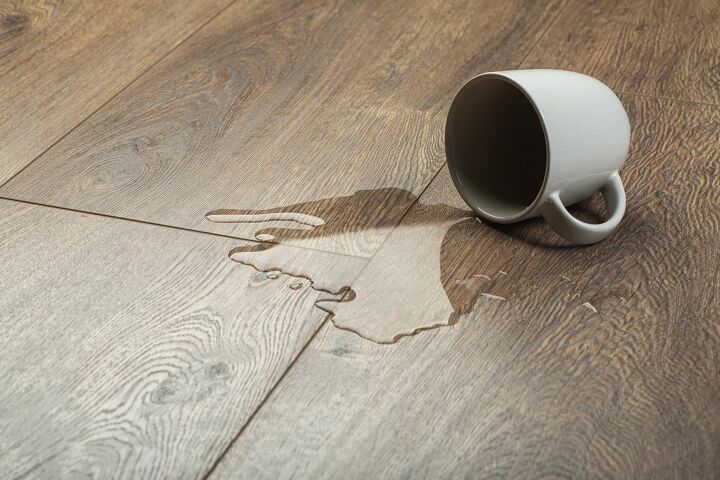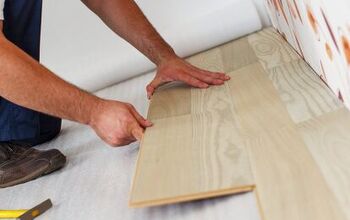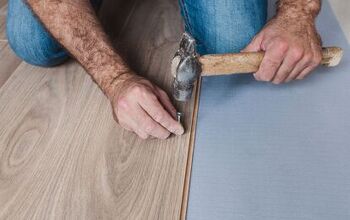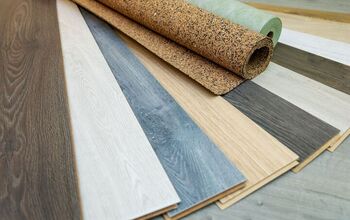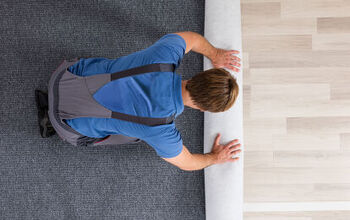Can Laminate Flooring Get Wet?

Laminate flooring is composed of particleboard, resin, and a print on top that mimics wood. It’s popular among homeowners for its ability to resist scratches, fading, stains, and other cosmetic imperfections.
However, it’s not impervious to damage. You may be wondering what to do if your dishwasher leaks under your laminate floor. You may also be concerned if water under your laminate floor in the basement is cause for concern.
Yes, laminate flooring can get wet as long as you mop up the mess immediately. If your floor floors or you don’t wipe up liquids at once, your laminate floor will get damaged. Warping, cracking, and swelling are common side effects of a flooded laminate floor. Preventing leaks and repairing the damage quickly are easy ways to protect your floor.
This low-maintenance flooring may be hardy but laminate still requires some precautionary measures. We’ll cover everything you need to know about water damage and laminate flooring here.
Do You Need Laminate Wood or Stone Flooring Installers?
Get free, zero-commitment quotes from pro contractors near you.

Can You Get Laminate Flooring Wet?
Laminate flooring is a great choice for homes with pets, children, and big families. It can keep up with daily wear and tear. It is also relatively easy to install.
Laminate flooring’s durability depends on the brand. In general, laminate flooring can get wet, given you ensure it is never saturated with water or flooded.
What Happens to Laminate Flooring When It Gets Wet
When your laminate flooring is flooded, the water seeps into the various floor layers. This excess moisture results in warping and swelling that jeopardizes your floor’s integrity. In the end, your laminate boards may even break apart.
Will Laminate Flooring Warp?
If liquid reached the bottom layers (e.g. the backing layer), your laminate flooring will warp. However, keep in mind that warping can also be caused by improper installation.
Will Laminate Flooring Dry Out?
Yes, soaked laminate flooring will dry out. The bad news is, the soaked part of your floor may need to be replaced once it’s finished drying. Moreover, mold can grow as quickly as 24 to 48 hours after your floor gets wet.
Taking out the laminate boards may speed up the drying time. The longer the liquid was left on your flooring, the longer the drying time. Even then, full drying is not guaranteed.
How Much Water Can Laminate Flooring Take?
Laminate flooring tolerates common liquid messes like spills from a cup, pet messes, or excess humidity. However, leaks from a burst pipe, underground sewage system, or groundwater floods are likely to damage your flooring beyond repair.
How Do You Tell if Your Laminate Floor is Sealed?
You moved into a home with laminate flooring, and you may be unsure if the floor is sealed or not. Fortunately, you can perform a simple test.
Sprinkle some water over your floor. If the laminate absorbs the water or the floor turns into a different color, it’s unsealed.
You can also go by sight. If there is a clear coating on top that looks separate from the boards, your floor is sealed. Note that laminate cannot be stained, but you can paint it if you suspect that it’s unsealed.
Can Laminate Floors Go In Bathrooms?
Yes, you can place laminate boards in bathrooms. This material is best suited for half-baths or rarely used guest bathrooms with tubs and showers. Bathrooms with just a toilet and sink create less humidity.
However, you may take steps to protect your laminate floor when placed in a bathroom. Laying down rugs, ventilating the room properly, and mopping up standing water are advised.
Renovators also recommend using waterproof silicone caulk or sealing your boards.
Is Laminate OK for Kitchen Use?
The kitchen is the center of the home. From cooking to dining, spills are bound to happen. Plus, your dishwasher or refrigerator can also leak.
Is laminate approved for kitchen use? Yes, laminate is suitable for kitchens. Laminate boards contain a wear layer that keeps them shielded from stains, scratches, fading, and light water exposure.
Laminate is also available in many wood colors and patterns. Hence, it’s easy to find one that complements your kitchen.
What to Do if a Laminate Floor Gets Wet
When it comes to saving your floor laminate from permanent water damage, time is of the essence. You must make haste, especially if the water’s reached underneath the laminate.
- Clean/Mop Up the Mess: The smaller the spill and the quicker you act, the higher the chances are that your laminate flooring is okay.
- Assess the Damage: Make sure you’ve identified all the areas that are affected. This way, you can replace all the affected woods all at once and prevent further damage.
- Remove the Affected Boards: Use tools that can be wedged between the board and the floor, and lift up the planks.
- Let the Boards Dry: You might position the planks next to a fan, AC unit, or vent to help speed up the process.
- Replace Damaged Boards: If the boards have dried but you notice that they swelled up, they may need to be replaced. Installation is straightforward, but finding the exact same color or pattern may be the tricky part.
Symptoms Of Laminate Floor Damage
A laminate floor may not show damage instantly, especially if the issue exists beneath the flooring. Here are some signs to look out for.
- The edges are rising
- The boards are bubbling
- The boards are cracking/splitting
- The boards are buckling
- There is mold on the boards
- The boards are changing color
Ways to Protect Your Laminate Flooring
One of the best ways to protect laminate flooring is to prevent damage. Although it is a hardy flooring choice, you can boost its durability further by taking these steps.
Ensure Appliances and Water Systems Are in Top Shape
Serious water damage often stems from failed water pipes, water tanks, refrigerators, and dishwashers. Performing regular inspections can help save your floors. This may also protect other structures in your home such as walls and furniture.
Apply Protective Coating
You can apply a polyurethane coat on top of your laminate to make it more water-repellent.
Seal the Joints
Where the laminate planks meet, there is space that water can seep through. You can seal this weak point with a waterproof sealant or caulk to keep out water.
Use Mats, Rugs, or Pads Wherever Possible
Use rugs, mats, or runners to protect your laminate floor from blemishes and spills. Rooms like the kitchen, living room, and half-baths are especially crucial since they are high-traffic areas.
Prevent Excess Moisture
Humidity is unavoidable in the home, especially in the kitchen and bathroom. When possible, use your exhaust fans in the kitchen and bathroom. Address and fix leaky pipes to avoid introducing moisture into the home.
You may also run a dehumidifier or the dehumidifying function on your AC unit if you have one.
Pad Furniture Feet
Place non-marring feet or pads on your chairs, tables, sofas, etc. to keep your laminate flooring looking new. This also helps keep the clear top layer intact.
Do You Need Laminate Wood or Stone Flooring Installers?
Get free, zero-commitment quotes from pro contractors near you.

Related Questions
Can vinyl flooring get wet?
Vinyl planks are waterproof, so they can get wet. However, the trouble is if water reaches your flooring and has no way to dry. In this case, you may need to remove the vinyl planks and let the area dry off.
Can you leave laminate flooring outside in the rain?
Laminate flooring does not tolerate standing water, so it is not advised to leave it outside in the rain. It is also not recommended for outdoor flooring or furnishing.
Are you supposed to seal laminate floors so they become more water-resistant?
Most laminate boards are sold sealed, but you can seal them yourself. Use water-resistant or water-proof sealant and caulk to seal the planks together. You can also apply a layer of a waterproof coating such as polyurethane.

We are a team of passionate homeowners, home improvement pros, and DIY enthusiasts who enjoy sharing home improvement, housekeeping, decorating, and more with other homeowners! Whether you're looking for a step-by-step guide on fixing an appliance or the cost of installing a fence, we've here to help.
More by Upgraded Home Team



